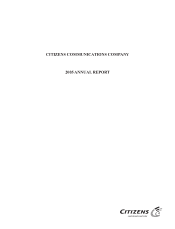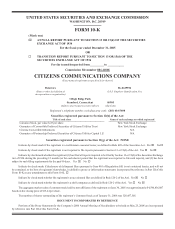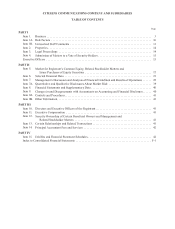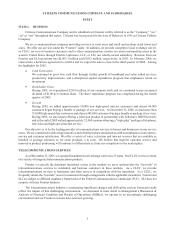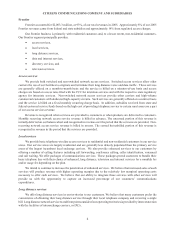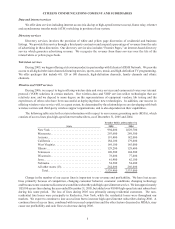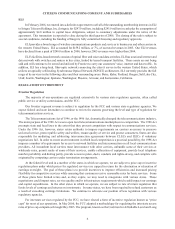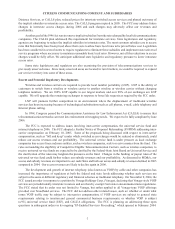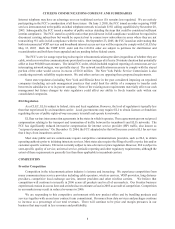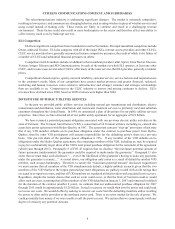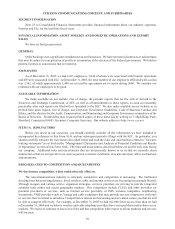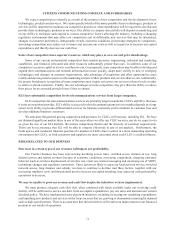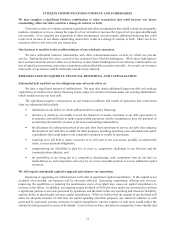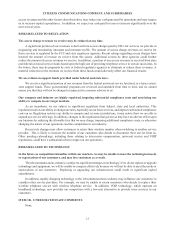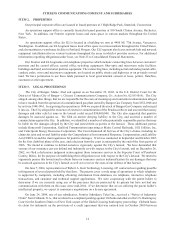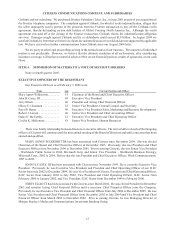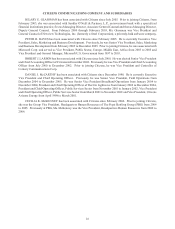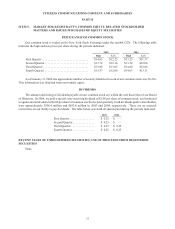Frontier Communications 2005 Annual Report Download - page 9
Download and view the complete annual report
Please find page 9 of the 2005 Frontier Communications annual report below. You can navigate through the pages in the report by either clicking on the pages listed below, or by using the keyword search tool below to find specific information within the annual report.7
CITIZENS COMMUNICATIONS COMPANY AND SUBSIDIARIES
Distance Services, or CALLS plan, reduced prices for interstate-switched access services and phased out many of
the implicit subsidies in interstate access rates. The CALLS program expired in 2005. The FCC may address future
changes in interstate access charges during 2006 and such changes may adversely affect our revenues and
profitability.
Another goal of the 1996 Act was to remove implicit subsidies from the rates charged by local telecommunications
companies. The CALLS plan addressed this requirement for interstate services. State legislatures and regulatory
agencies are beginning to reduce the implicit subsidies in intrastate rates. The most common subsidies are in access
rates that historically have been priced above their costs to allow basic local rates to be priced below cost. Legislation
has been considered in several states to require regulators to eliminate these subsidies and implement state universal
service programs where necessary to maintain reasonable basic local rates. However, not all the reductions in access
charges would be fully offset. We anticipate additional state legislative and regulatory pressure to lower intrastate
access rates.
Some state legislatures and regulators are also examining the provision of telecommunications services to
previously unserved areas. Since many unserved areas are located in rural markets, we could be required to expand
our service territory into some of these areas.
Recent and Potential Regulatory Developments
Wireline and wireless carriers are required to provide local number portability (LNP). LNP is the ability of
customers to switch from a wireline or wireless carrier to another wireline or wireless carrier without changing
telephone numbers. We are 100% LNP capable in our largest markets and over 98% of our exchanges are LNP
capable. We will upgrade the remaining exchanges in response to bona fide requests as required by the FCC order.
LNP will promote further competition in an environment where the displacement of traditional wireline
services has been increasing because of technological substitutions such as cell phones, e-mail, cable telephony and
Internet phone calling.
In 1994, Congress passed the Communications Assistance for Law Enforcement Act (CALEA) to ensure that
telecommunication networks can meet law enforcement wiretapping needs. We expect to be fully compliant by June
2006.
The FCC is expected to address issues involving inter-carrier compensation, the universal service fund and
internet telephony in 2006. The FCC adopted a Further Notice of Proposed Rulemaking (FNPRM) addressing inter-
carrier compensation on February 10, 2005. Some of the proposals being discussed with respect to inter-carrier
compensation, such as “bill and keep” (under which switched access charges would be reduced or eliminated), could
reduce our access revenues and our profitability. The universal service fund is under pressure as local exchange
companies lose access lines and more entities, such as wireless companies, seek to receive monies from the fund. The
rules surrounding the eligibility of Competitive Eligible Telecommunication Carriers, such as wireless companies, to
receive universal service funds are expected to be clarified by the Federal-State Joint Board on Universal Service and
the clarification of the rules may heighten the pressures on the fund. Changes in the funding or payout rules of the
universal service fund could further reduce our subsidy revenues and our profitability. As discussed in MD&A, our
access and subsidy revenues are important to our cash flows and both our access and subsidy revenues declined in 2005
compared to 2004. Our access revenues are likely to decline again in 2006.
The development and growth of internet telephony (also known as VOIP) by cable and other companies has
increased the importance of regulators at both the federal and state levels addressing whether such services are
subject to the same or different regulatory and financial schemes as traditional telephony. On November 9, 2004, the
FCC issued an order in response to a petition by Vonage Holdings Corp. (Vonage), declaring that Vonage-style VOIP
services are jurisdictionally interstate in nature and are thereby exempt from state telecommunications regulations.
The FCC stated that its order was not limited to Vonage, but rather applied to all Vonage-type VOIP offerings
provided over broadband services. The FCC did not address other related issues, such as: whether or under what
terms VOIP traffic may be subject to intercarrier compensation; if VOIP services are subject to general state
requirements relating to taxation and general commercial business requirements; or whether VOIP is subject
to 911, universal service fund (USF), and CALEA obligations. The FCC is planning on addressing these open
questions in subsequent orders in its ongoing “IP-Enabled Services Proceeding,” which opened in February 2004.

